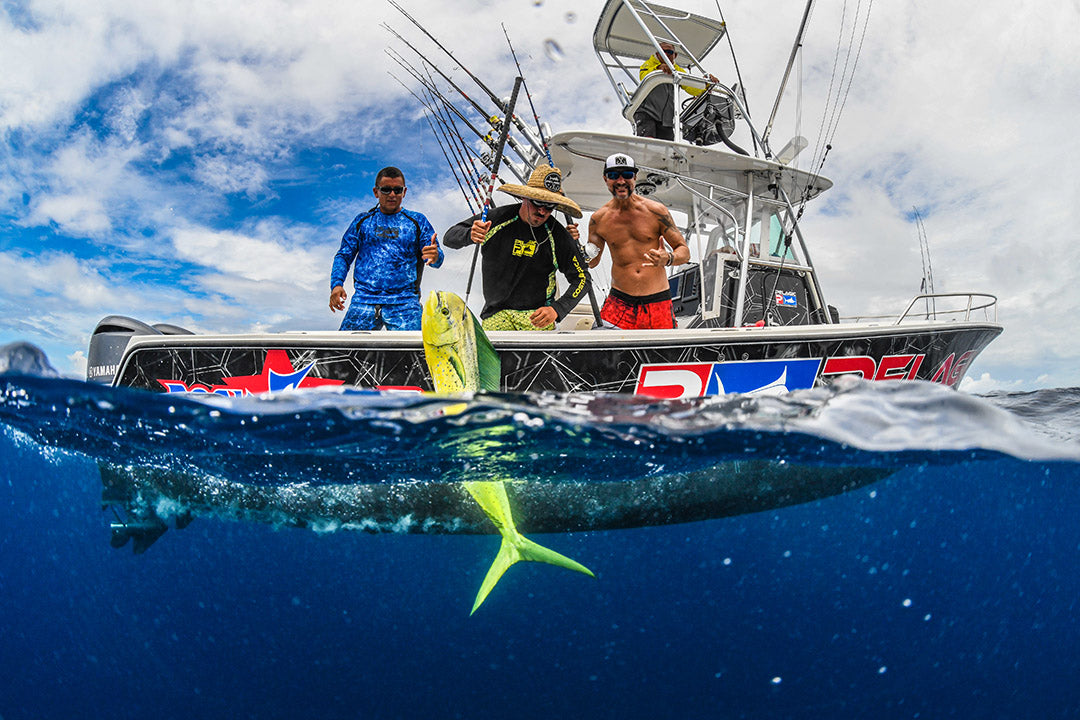SPECIES PROFILE: Dorado, Mahi-Mahi, Llampuga.
Mahi-Mahi: the fish so beautiful, they named it twice. Scientific name, Coryphaena hippurus, also known as dorado or dorado; Mahi-Mahi is one of the most sought after fish in the sea by fishermen because they are downright beautiful fighters, bravely strong, and perform a show of aerial acrobatics when hooked. Mahi-Mahi also present amazing colour patterns and variations while offering incredible food on the table, added reasons why they are arguably one of the most respected pelagic species in our oceans. Whatever you call them, Mahi is truly a fan favourite and we wanted to share a little more information about this amazing creature.
Often presenting a supreme aerial display when engaged, the mahi-mahi is sure to stun with incredible acrobatic performances. [Adrian grey]

Mahi-Mahi are easy to identify due to their brightly coloured patterns and unique body shape. They are usually vibrant green with yellow and blue highlights, but also alternate their colours with lighter shades of blue and even metallic silvers. They have special colour-changing cells called chromatophores, which are three-dimensional cells that contain pigments and reflect light, giving them the ability to flicker their colours. These chromatophores are connected to the fish's nervous system, which drives them to change colour when they are excited, and also the reason why their colour fades when they die.
Bright colour variations, from vibrant greens and yellows to cool blues and silvers, make mahi-mahi a true fan favourite.


The Mahi-Mahi has a long, slender body that tapers into a blunt head, but the shape of the head varies in males and females. Male mahi-mahi (often referred to as "bulls") have a much more pronounced flat forehead, almost 90°, while female "cows" have a more rounded, conical head. They are one of the fastest growing fish in the sea, reaching a length of up to four feet in the first year of life and over six feet in four years. They reach sexual maturity at four to five months of age while reproducing two to three times a year and females lay between 800 000 and 1 000 000 eggs during each cycle. The average mahi lives for two to three years, with some fish aging beyond five years. The International Game Fish Association lists the current world record All-Tackle Mahi-Mahi Mahi-Mahi caught in 1976 off the coast of Costa Rica weighing an astonishing 87 lbs. 0 oz.
Note the clear difference in the rounded/sharp forehead of the female "cow" mahi (above), versus the sharp 90° profile of the blunt facial profile of the male "bull".


Mahi-Mahi live in tropical and subtropical regions of the Atlantic, Pacific and Indian Oceans. They live predominantly in open oceans following currents and preferred temperature changes, and often associate with floating objects such as sargassum weed, seaweed, litter and FAD, which attract other life forms on which the Mahi feed. Mahi feed mainly during the day, and some of their prey are small fin baits, cephalopods and crustaceans.
Discovering that the floating pot of gold on the high seas can produce some important catches of many pelagic species, including today's subject: mahi mahi. [Steve Dougherty | Adrian Gray].
VISIT THE NEWS ON PELAGIC'S WEBSITE : https://pelagicgear.com/blogs/news/species-profile-the-brilliant-mahi-mahi
